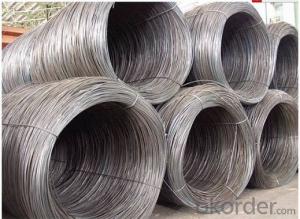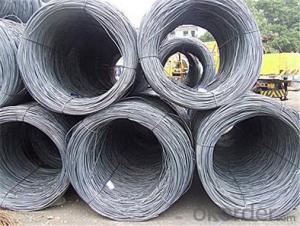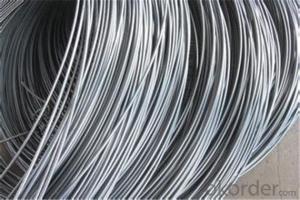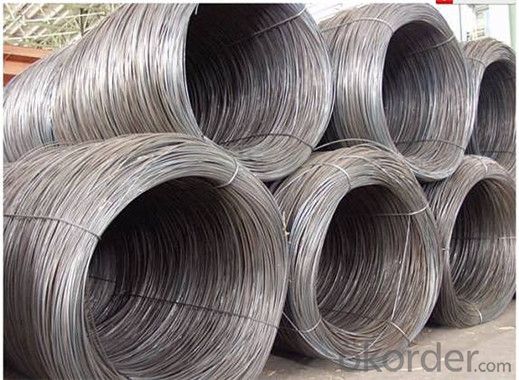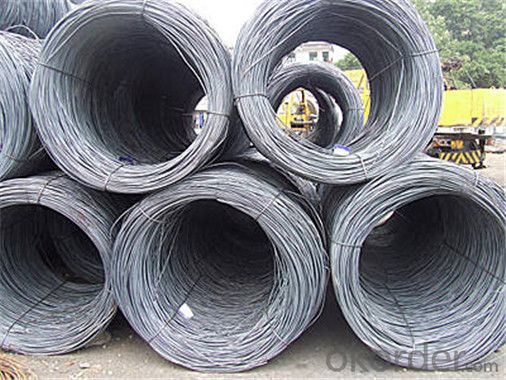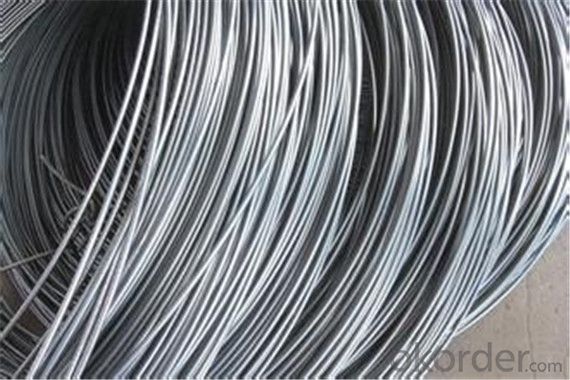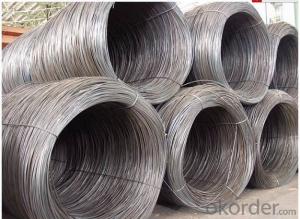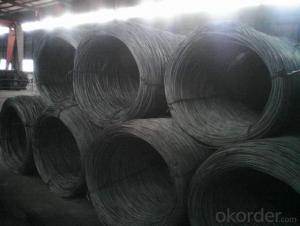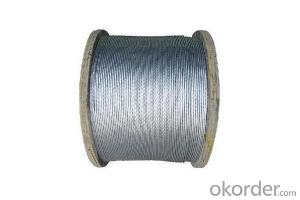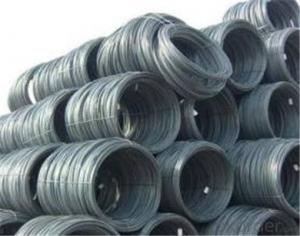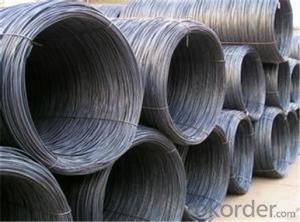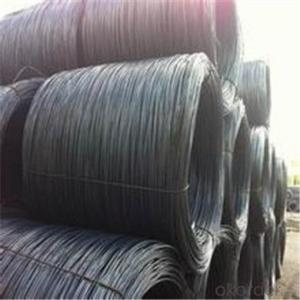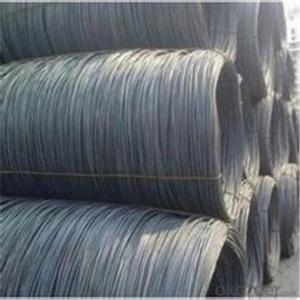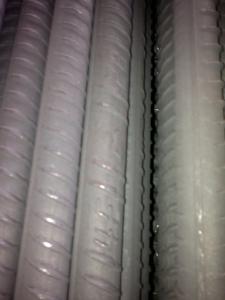SAE1006B Steel Wire Rod 6.5mm with in China
- Loading Port:
- Tianjin
- Payment Terms:
- TT OR LC
- Min Order Qty:
- 500 m.t.
- Supply Capability:
- 45555555 m.t./month
OKorder Service Pledge
OKorder Financial Service
You Might Also Like
Specification
Description of wire Rod:
Our company is recognized by ISO9001:2008
1. hot rolled wire rod
2. material: Q195-235
3. payment: T/T or L/C
4.size: 5mm-19mm
Festures of wire Rod:
1. Drawn wire specialist, your wire rod solution
2. ISO9001 Certified Mill &SGS
3. Feature: machinability, high hardness, toughness, corrosion resistant
4. Clear and smooth surface, high precision and Tolerance control: ± 0.01
Specifications of wire Rod:
Product | steel wire rod |
Standard | AISI, ASTM, BS, DIN, GB, JIS |
Material/steel grade | Q195-Q235,SAE1006, SAE1008, SAE1010, SAE1018, SAE1020 or according to customers requirements |
Wire Gauge | 5.5-12mm |
Coil weight | 1.8-2.1mts |
MOQ | 25MT |
Delivery Time | 15-30 days after receipt of L/C or deposit by T/T |
Packing | In coil and load in container, if large quantity, by bulk vessel; Can be packed as customers' special requirements |
Payment terms | 1).100% irrevocable L/C at sight. |
Application | widely used in machinery parts, manufacturing industry, electronics industry, metal tools and others |
Images of wire Rod:
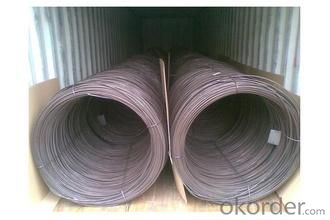
FAQ:
1. What is your package?
Packing situation: standard seaworthy packing or as customer required.
2. How long is the lead time?
Delivery time: 45 days after order confirmed.
3. What payment term do you accept?
Payment: T/T or L/C at sight.
- Q: What are the main factors affecting the market forecasts of steel wire rod?
- The main factors affecting the market forecasts of steel wire rod include global economic conditions, demand and supply dynamics, raw material prices, government policies and regulations, technological advancements, competition within the industry, and geopolitical factors.
- Q: What are the main factors affecting the customer satisfaction with steel wire rod?
- The main factors affecting customer satisfaction with steel wire rod include the quality of the product, its durability and strength, its suitability for the intended application, timely delivery, competitive pricing, reliable customer service, and adherence to specifications and standards.
- Q: What are the main challenges in manufacturing steel wire rod?
- There are several main challenges in manufacturing steel wire rod. One of the challenges is ensuring consistent quality and uniformity in the wire rod production. This involves maintaining precise control over the chemical composition and mechanical properties of the steel, as any deviation can affect the performance and reliability of the final product. It requires strict adherence to quality control procedures and continuous monitoring throughout the manufacturing process. Another challenge is achieving the desired dimensional accuracy and surface finish of the wire rod. This involves controlling the temperature and speed during the rolling process to ensure proper shape and size. Any irregularities or defects in the wire rod can affect its strength and durability, making it unsuitable for its intended applications. Maintaining a high production rate while ensuring safety and minimizing downtime is also a significant challenge. Steel wire rod manufacturing typically involves complex machinery and equipment, which require regular maintenance and monitoring to prevent breakdowns. Additionally, ensuring worker safety in such an environment requires implementing strict safety protocols and providing appropriate safety equipment. Environmental sustainability is another challenge in manufacturing steel wire rod. The production process involves high energy consumption and emissions of greenhouse gases. Reducing the environmental impact requires implementing energy-efficient technologies, recycling and reusing waste materials, and adopting sustainable practices throughout the entire production chain. Furthermore, the steel wire rod industry faces the challenge of increasing competition and fluctuating market demands. Manufacturers need to stay updated with the latest market trends, adapt to changing customer requirements, and constantly innovate to remain competitive. This includes investing in research and development to improve product quality, develop new alloys, and explore alternative manufacturing methods. Overall, manufacturing steel wire rod requires addressing challenges related to quality control, dimensional accuracy, safety, environmental sustainability, and market competitiveness. Overcoming these challenges requires a combination of advanced technology, skilled workforce, and continuous improvement in manufacturing processes.
- Q: What are the advantages of using steel wire rod in telecommunication applications?
- The advantages of using steel wire rod in telecommunication applications include its high tensile strength, durability, and resistance to corrosion. Steel wire rod provides a reliable and strong support structure for telecommunication cables, ensuring efficient transmission of signals over long distances. Additionally, steel wire rod is cost-effective, readily available, and easily installable, making it a preferred choice in telecommunication infrastructure.
- Q: What are the different types of steel wire rod surface treatments?
- The different types of steel wire rod surface treatments include galvanizing, coating, passivating, and pickling.
- Q: What are the different inclusion testing methods for steel wire rod?
- Steel wire rod commonly undergoes several different inclusion testing methods to detect and analyze non-metallic impurities that can affect its quality and performance. One method frequently used is microscopic examination. This involves taking a sample of the wire rod and preparing it for examination under a microscope. The sample is typically polished and etched to enhance visibility. By observing the size, shape, and distribution of the inclusions, they can be identified and characterized. Another widely employed inclusion testing method is ultrasonic testing. This technique employs high-frequency sound waves to detect and analyze inclusions in the wire rod. The waves pass through the material, and any disturbances caused by inclusions are detected and analyzed. This method provides information about the size, location, and type of inclusions present. In addition to these methods, more advanced techniques are available for inclusion testing. These include scanning electron microscopy (SEM), energy-dispersive X-ray spectroscopy (EDS), and X-ray diffraction (XRD). SEM allows for highly detailed imaging of inclusions, while EDS provides elemental analysis. XRD is used to determine the crystallographic structure of the inclusions. The choice of inclusion testing method depends on several factors, such as required accuracy, the specific type of inclusions of interest, and available equipment and expertise. Each method has its own advantages and limitations, so it is often advantageous to use a combination of techniques to gain a comprehensive understanding of the inclusions in steel wire rod.
- Q: How is the ductility of steel wire rod measured?
- The ductility of steel wire rod is typically measured using a test called the tensile test. In this test, a sample of the wire rod is pulled in opposite directions until it breaks. The elongation and reduction in cross-sectional area of the wire rod during the test are then measured to determine its ductility.
- Q: How is steel wire rod used in the manufacturing of wire for shopping carts?
- Steel wire rod is used in the manufacturing of wire for shopping carts as it serves as the primary raw material. It is first drawn into the desired thickness and then bent or welded to form the framework and structure of the cart. The strength and durability of steel wire rod make it an ideal choice for withstanding the weight and load-bearing requirements of shopping carts in various commercial settings.
- Q: How is steel wire rod sized for specific applications?
- Steel wire rod is sized for specific applications through a process called wire drawing. In this process, the rod is pulled through a series of dies with progressively smaller openings. This reduces the diameter of the rod while increasing its length. The number of passes through the dies determines the final size and shape of the wire, allowing it to be tailored to meet the requirements of various applications, such as construction, automotive, or electrical industries.
- Q: How is steel wire rod used in the manufacturing of wire for power generation systems?
- Wire rod made of steel is a crucial raw material utilized in the production of wire for power generation systems. It acts as the main material for manufacturing top-quality cables used for transmitting and distributing electricity from power plants to various destinations. The manufacturing process commences by carefully selecting steel wire rod based on its specific properties, such as strength, durability, and conductivity. The rod is then heated to the suitable temperature and passed through a series of dies to shape it into the desired wire diameter. This process, known as wire drawing, involves reducing the rod's diameter while increasing its length. After the wire has been drawn to the required size, it undergoes various treatments to enhance its mechanical properties. These treatments may include annealing, where the wire is heated and gradually cooled to relieve internal stresses and improve its flexibility and ductility. Additionally, the wire may be galvanized, which involves applying a protective layer of zinc to prevent corrosion and prolong its lifespan. The manufactured wire is then utilized in the construction of power transmission and distribution cables. These cables play a crucial role in efficiently and safely delivering electricity over long distances. The steel wire provides the necessary strength and tensile properties to support the cables' weight and withstand the mechanical stresses during installation and operation. It also ensures that the cables maintain their shape and structure even when subjected to external forces like wind, ice, and temperature changes. Furthermore, the electrical conductivity of the steel wire allows for efficient transmission of electricity, reducing power losses during transmission. This property is particularly important in power generation systems, where minimizing energy losses is vital for the effective and economical delivery of electricity. In conclusion, steel wire rod is an indispensable component in the production of wire for power generation systems. It possesses the required mechanical strength, durability, and electrical conductivity needed for power transmission and distribution cables. By enabling efficient and reliable electricity transmission, steel wire plays a crucial role in powering our homes, businesses, and industries.
Send your message to us
SAE1006B Steel Wire Rod 6.5mm with in China
- Loading Port:
- Tianjin
- Payment Terms:
- TT OR LC
- Min Order Qty:
- 500 m.t.
- Supply Capability:
- 45555555 m.t./month
OKorder Service Pledge
OKorder Financial Service
Similar products
Hot products
Hot Searches
Related keywords
